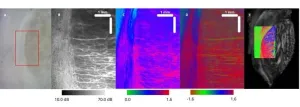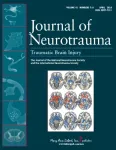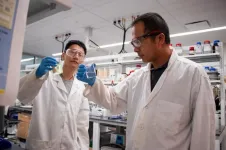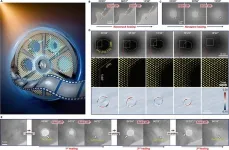(Press-News.org) In a new study, researchers compared the orientations of nerve fibers in a human brainstem using two advanced imaging techniques: diffusion magnetic resonance imaging (dMRI)-based tractography and polarization sensitive optical coherence tomography (PS-OCT). The findings could aid in combining these techniques, which each offer unique advantages, to advance our understanding of the brain’s microstructure and help inform new techniques for early diagnosis of various brain disorders.
Isabella Aguilera-Cuenca from the University of Arizona will present this research at Frontiers in Optics + Laser Science (FiO LS), which will be held 23 – 26 September 2024 at the Colorado Convention Center in Denver.
“Neurodegenerative diseases are becoming increasingly widespread as lifespans increase and populations age – better understanding the link between brain microstructure and these diseases could lead to developing improved methods for prevention, detection, and management,” said Aguilera-Cuenca.
Nerve fiber orientation is an important aspect of brain microstructure due to its influence on the connectivity and communication pathways in the brain. One way to study this microstructure is by using dMRI, a non-invasive method imaging method that uses water molecule diffusion to reveal structural connectivity. A specialized application of dMRI known as diffusion tensor imaging (DTI) can be used to reconstruct nerve fiber pathways through a process known as tractography. Although DTI is sensitive to differences across brain tissue environments, it can’t detect specific cellular changes and can only resolve nerve tracts, not individual axon orientations.
PS-OCT is also useful for studying brain microstructure. It uses the properties of back-scattered light and variations in polarization to create depth-resolved cross-sectional images of tissue microstructures. This information can be used to identify fiber tracts with micrometer-scale resolution and distinguish between white and gray matter. However, in scattering media such as brain tissue, PS-OCT can only image up to a few millimeters deep.
To conduct a quantitative comparison of nerve fiber orientation distributions with dMRI-based tractography and PS-OCT, the researchers used both techniques to image a human brainstem sample fixed in paraformaldehyde and then stored in PBS with sodium azide.
The results showed that polarization properties of phase retardation and optic axis can be used to map nerve fiber presence and orientation in brain tissue, similar to results obtained via dMRI. This indicates the strong potential for PS-OCT to validate dMRI data, providing valuable insights about the microstructural organization of nerve fibers, which is crucial for understanding normal physiology and the changes that may occur with neurodegenerative conditions.
“To further advance this work, we will study the microstructural alterations in a range of brain regions from patients with different neurodegenerative conditions, with the goal of identifying alterations that occur with the onset of disease, said Aguilera-Cuenca. “We hope this work eventually translates into new approaches for early detection of these pathologies.”
About Frontiers in Optics + Laser Science
Frontiers in Optics, the annual meeting for Optica (formerly OSA) is presented with Laser Science, the annual meeting of the American Physical Society, Division of Laser Science. The two meetings unite communities from both societies for comprehensive and current research in a diverse collection of optics and photonics topics and across the disciplines of physics, biology and chemistry. The 2024 FiO LS Conference will feature hundreds of live contributed and invited talks. More information at https://www.frontiersinoptics.com.
About Optica
Optica, Advancing Optics and Photonics Worldwide, is the society dedicated to promoting the generation, application, archiving and dissemination of knowledge in the field. Founded in 1916, it is the leading organization for scientists, engineers, business professionals, students and others interested in the science of light. Optica's renowned publications, meetings, online resources and in-person activities fuel discoveries, shape real-life applications and accelerate scientific, technical and educational achievement. Discover more at: Optica.org
END
Integrating MRI and OCT for new insights into brain microstructure
Researchers compare nerve fiber orientation captured with specialized MRI and OCT approaches, laying groundwork for combining these imaging techniques
2024-09-06
ELSE PRESS RELEASES FROM THIS DATE:
Designing a normative neuroimaging library to support diagnosis of traumatic brain injury
2024-09-06
With recent advances in neuroimaging, moving from qualitative to quantitative outputs, an understanding is needed of what normal data look like to be able to apply these advances to diagnosis and outcomes prediction in traumatic brain injury (TBI). A new article in the peer-reviewed Journal of Neurotrauma introduces the large Normative Neuroimaging Library (NLL) to the research community. Click here to read the article now.
The American College of Radiology and Cohen Veterans Bioscience created a reference ...
Department of Energy announces $68 million in funding for artificial intelligence for scientific research
2024-09-06
WASHINGTON, D.C. - The use of Artificial Intelligence (AI) in scientific research is a top priority at the Department of Energy (DOE), which today announced $68 million in funding for 11 multi-institution projects, comprising 43 awards.
The funded projects will develop new ways to create foundation models, which are machine learning or deep learning models that can be used across a wide range of applications because they’re trained on broad data. Foundation models are a key building block of AI.
Those models will be used in computational science, to automate workflow in laboratories, to accelerate scientific programming, and much more. The possibilities ...
DOE, ORNL announce opportunity to define future of high-performance computing
2024-09-06
The Department of Energy’s (DOE) Office of Science today announced a new research and development opportunity led by Oak Ridge National Laboratory (ORNL) to advance technologies and drive new capabilities for future supercomputers. This industry research program worth $23 million, called New Frontiers, will initiate partnerships with multiple companies to accelerate the R&D of critical technologies with renewed emphasis on energy efficiency for the next generation of post-exascale computing in the 2029 and beyond time frame.
“There is a growing consensus that urgent action is needed to address an array of bottlenecks ...
Molecular simulations, supercomputing lead to energy-saving biomaterials breakthrough
2024-09-06
A team led by scientists at the Department of Energy’s Oak Ridge National Laboratory identified and successfully demonstrated a new method to process a plant-based material called nanocellulose that reduced energy needs by a whopping 21%. The approach was discovered using molecular simulations run on the lab’s supercomputers, followed by pilot testing and analysis.
The method, leveraging a solvent of sodium hydroxide and urea in water, can significantly lower the production cost of nanocellulosic fiber — a strong, lightweight biomaterial ideal as a ...
Low-impact yoga and exercise found to help older women manage urinary incontinence
2024-09-06
Older women struggling with urinary incontinence can benefit from regular, low-impact exercise, with yoga as well as stretching and strengthening showing benefits in a new study published Aug. 27 in Annals of Internal Medicine.
The research, led by scientists at Stanford Medicine and the University of California, San Francisco, is part of a larger effort to identify low-risk, low-cost ways to treat one of the most common health problems women face as they age.
After 12 weeks of a low-impact yoga program, study participants had about 65% fewer episodes of incontinence. Women in a control group doing stretching and strengthening exercises ...
Genetic studies reveal new insights into cognitive impairment in schizophrenia
2024-09-06
In a comprehensive review of recent genetic and population studies, published in the peer-reviewed medical journal Genomic Psychiatry (Genomic Press, New York), Professors Michael Owen and Michael O'Donovan of Cardiff University's Centre for Neuropsychiatric Genetics and Genomics present evidence that challenges conventional wisdom about cognitive deficits in schizophrenia. Their analysis reveals that premorbid cognitive impairment – lower IQ and other cognitive deficits present before the onset of psychosis – is largely explained by non-familial factors rather than by the same inherited genetic variants that ...
Researcher develops technology to provide cleaner energy and cleaner water
2024-09-06
As the world transitions to cleaner energy sources, the need for energy-relevant metals and critical minerals has surged dramatically. Driven by the rise of electric vehicles and other green technologies, these essential materials are in high demand across the globe.
Metals, such as lithium, cannot be grown. They must be mined or recycled, making this a top priority for researchers in the mining industry. Traditional methods of mining lithium are expensive and can be harmful to the environment, but researchers at Virginia Tech have found a way to minimize this environment impact. They will optimize and scale up this method with ...
Expect the unexpected: nanoscale silver unveils intrinsic self-healing abilities
2024-09-06
As an innovative concept in materials science and engineering, the inspiration of self-healing materials comes from living organisms that have the innate ability to self-heal. Along with this line, the search for self-healing materials has been generally focused on “soft” materials like polymers and hydrogels. For solid-state metals instead, one may intuitively imagine that any form of self-healing will be much more difficult to achieve.
While a few past studies showcased the self-healing behavior in metals that more or less requires the assistance ...
nTIDE September 2024 Jobs Report: Gains in employment for people with disabilities appear to level off after reducing gaps with non-disabled workers
2024-09-06
East Hanover, NJ – September 6, 2024 – Employment and labor force participation trends for people with disabilities appear to be stabilizing after several years of growth that reduced the gaps between individuals with and without disabilities, according to today’s National Trends in Disability Employment – semi-monthly update (nTIDE) issued by Kessler Foundation and the University of New Hampshire’s Institute on Disability (UNH-IOD).
Over the past three months, both groups have seen declines in employment and labor force participation, reflecting a broader workforce ...
Wiley enhances NMR Spectral Library Collection with extensive new databases
2024-09-06
Wiley, one of the world’s largest publishers and a global leader in research and learning, today announced the addition of ten computed CNMR databases totaling over 384,000 records to its KnowItAll NMR Spectral Library collection. With this addition, the KnowItAll NMR collection now provides access to over 1.3 million spectra, making it one of the most comprehensive collections of NMR spectral data available.
“These new databases significantly enhance our ability to support researchers in their quest ...
LAST 30 PRESS RELEASES:
Fat tissue around the heart may contribute to greater heart injury after a heart attack
Jeonbuk National University researcher proposes a proposing a two-stage decision-making framework of lithium governance in Latin America
Chromatin accessibility maps reveal how stem cells drive myelodysplastic progression
Cartilaginous cells regulate growth and blood vessel formation in bones
Plant hormone allows lifelong control of proteins in living animal for first time
Swedish freshwater bacteria give new insights into bacterial evolution
Global measures consistently underestimate food insecurity; one in five who suffer from hunger may go uncounted
Hidden patterns of isolation and segregation found in all American cities
FDA drug trials exclude a widening slice of Americans
Sea reptile’s tooth shows that mosasaurs could live in freshwater
Pure bred: New stem cell medium only has canine components
Largest study of its kind highlights benefits – and risks – of plant-based diets in children
Synergistic effects of single-crystal HfB2 nanorods: Simultaneous enhancement of mechanical properties and ablation resistance
Mysterious X-ray variability of the strongly magnetized neutron star NGC 7793 P13
The key to increasing patients’ advance care medical planning may be automatic patient outreach
Palaeontology: Ancient tooth suggests ocean predator could hunt in rivers
Polar bears may be adapting to survive warmer climates, says study
Canadian wildfire smoke worsened pediatric asthma in US Northeast: UVM study
New UBCO research challenges traditional teen suicide prevention models
Diversity language in US medical research agency grants declined 25% since 2024
Concern over growing use of AI chatbots to stave off loneliness
Biomedical authors often call a reference “recent” — even when it is decades old, analysis shows
The Lancet: New single dose oral treatment for gonorrhoea effectively combats drug-resistant infections, trial finds
Proton therapy shows survival benefit in Phase III trial for patients with head and neck cancers
Blood test reveals prognosis after cardiac arrest
UBCO study finds microdosing can temporarily improve mood, creativity
An ECOG-ACRIN imaging study solves a long-standing gap in metastatic breast cancer research and care: accurately measuring treatment response in patients with bone metastases
Cleveland Clinic presents final results of phase 1 clinical trial of preventive breast cancer vaccine study
Nationally renowned anesthesiology physician-scientist and clinical operations leader David Mintz, MD, PhD, named Chair of the Department of Anesthesiology at the UM School of Medicine
Clean water access improves child health in Mozambique, study shows
[Press-News.org] Integrating MRI and OCT for new insights into brain microstructureResearchers compare nerve fiber orientation captured with specialized MRI and OCT approaches, laying groundwork for combining these imaging techniques




